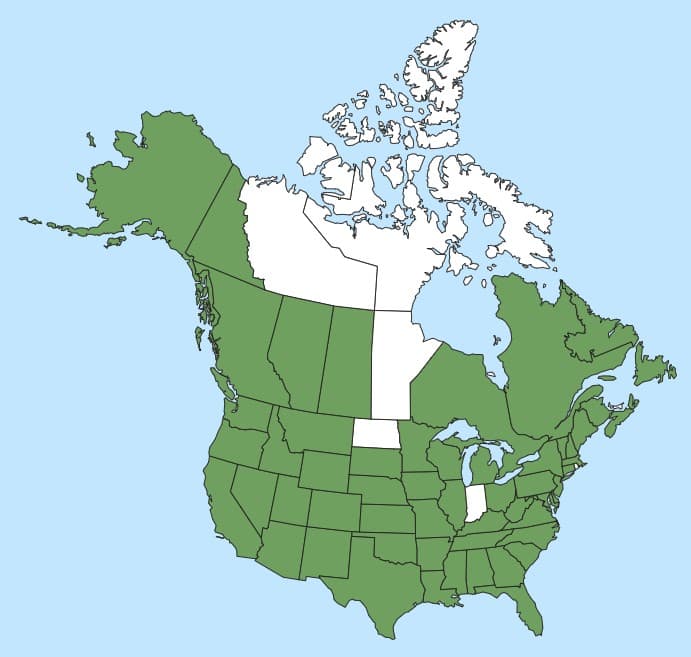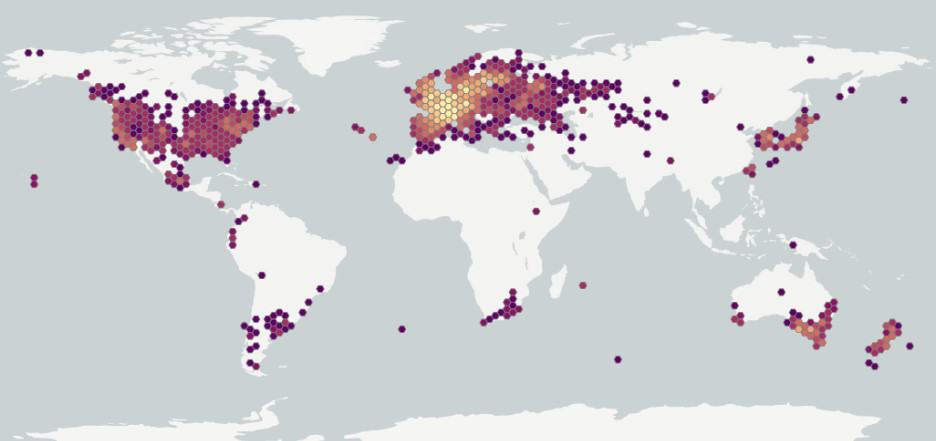Festuca arundinacea
Explore More :
Explore plus :
Overview
Aperçu
Regulation :
Remarques Réglementation:
- USA Federal Noxious Weed Seed List
Regulation Notes:
Classified as a noxious weed seed or undesirable grass species when found as a contaminant in grass seed marketed for lawn or turf purposes in certain US states (Delaware, Maryland, New Hampshire, New Jersey, Pennsylvania, Virginia, and West Virginia) (USDA-AMS 2022).
Distribution :
Répartition :
Festuca arundinacea is native to Europe, Northern Africa, temperate and tropical Asia and has been introduced and in many cases naturalized in Africa (Ethiopia, Kenya, South Africa), Australasia, Canada, Central America, China, Japan, Macaronesia, Mexico, South America (Argentina, Brazil, Chile, Ecuador, Uruguay), Taiwan, and the United States (including Hawaii) (CABI 2022; eFloras 2022; USDA-ARS 2022).
Habitat and Crop Association :
Habitat et Cultures Associées :
Native Festuca arundinacea grows in a wide range of habitats, tolerating varying soil nutrient and moisture levels, but preferring moist heavy soils (Alderson and Sharp 1995; CABI 2022). In its native range, F. arundinacea can be found in grasslands, meadows, woodlands, riparian areas, seashores, and in both freshwater and saline wetlands (CABI 2022).
Through introduction as a pasture grass outside its native range, this species has escaped cultivation and naturalized in prairies, forest edges, coastal scrub, along roadsides, ditches, and other disturbed areas. In some places F. arundinacea is considered an invasive species because it will out compete native species and reduce biodiversity (CABI 2022).
Economic Use, cultivation area, and Weed Association :
Utilisation économique, zone de culture et association de mauvaises herbes :
Festuca arundinacea is a cool-season, coarse textured, deep-rooted, perennial bunchgrass with short rhizomes (Cronquist et al. 1977; Alderson and Sharp 1995; Young III 1997). This species is cultivated in various places around the world for pasture, hay, turf, and erosion control (Alderson and Sharp 1995). In the northeastern United States this species is classified as a noxious weed seed when found as a contaminant in turf grass seed lots (USDA-AMS 2022).
Duration of Life Cycle :
Durée du cycle vital:
Perennial
Dispersal Unit Type :
Type d’unité de dispersion :
Floret
General Information
RENSEIGNEMENTS GÉNÉRAUX
Festuca arundinacea is a cool season perennial grass. The primary growth and sexual reproduction period occur during spring and a secondary vegetative growth period occurs in fall. Reproduction is both sexual and vegetative. Under turf and pasture conditions reproduction is primarily achieved vegetatively with spread via rhizome (CABI 2022).
Plants may be infected with Neotyphodium spp. [Acremonium spp.] , an endophytic fungus. The plant-endophyte interaction produces a number of alkaloids, some beneficial and enhancing insect and drought resistance in the plants, while other alkaloids produced render the foliage toxic to livestock and are associated with detrimental animal health issues including staggers, heat stress, and low animal growth rate (Rolston et al. 1997; Nihsen et al. 2004; Barkworth et al. 2007). Endophyte free F. arundinacea does not have the same resistance qualities for difficult environmental conditions but is preferred where livestock welfare is an issue.
.Identification
Identification
-
Spikelet
Size
- Spikelet length: 5 – 15.5 mm; spikelet width 2 – 3.5 mm.*
*Note: size range based on literature sources (Tutin et al. 1980; Barkworth et al. 2007; eFloras 2022).
Spikelet size from literature:
• Spikelet length: 5 – 12 mm (Tutin et al. 1980).
• Spikelet length: 8 – 15.5 mm; spikelet width 2 – 3.5 mm (Barkworth et al. 2007).
• Spikelet length: 8 – 15 mm (eFloras 2022).Shape
- Spikelet elongate egg-shaped; laterally compressed.
Surface Texture
- Surface with dull, coarse granular texture.
Colour
- Light yellow to light brown coloured, sometimes green or purple tinged.
Other Features
Spikelet composition
- The spikelet is usually composed of 3 – 7 similar looking florets with distal floret usually sterile and slightly smaller in size**.
**Note: spikelet composition based on literature sources (Tutin et al. 1980; Barkworth et al. 2007; eFloras 2022).
Spikelet composition from literature:
• Spikelet with 4 – 5 florets (Tutin et al. 1980).
• Spikelet with 3 – 6 (9) florets (Barkworth et al. 2007).
• Spikelet with (2) 3 – 7 florets (eFloras 2022).Glumes
- Glumes narrowly teardrop-shaped; lower glume 3 – 6 mm long; upper glume 4.5 – 7 (9) mm long; both without hairs (Barkworth et al. 2007; eFloras 2022).
- Lower glume 1 – 3 nerved; upper glume 3 – 5 nerved, margins of glumes membranous (Cronquist et al. 1977).
Disarticulation
- Disarticulation of spikelets occurs above the glumes and between the florets at the rachilla nodes.
-
Floret
Size
- Floret length: 4.3 – 8.2 mm (average 6.6 mm); floret width: 0.9 – 1.7 mm (average 1.4 mm) (D. Meyer*).
- Floret length: 3.9 – 7.1 mm; width: 0.9 – 1.6 mm (CFIA**).
- Rachilla length*: 0.8 – 1.9 mm (average 1.2 mm); rachilla width: 0.17 – 0.37 mm (average 0.25 mm).
- Awn length*: 0.3 – 3.3 mm (average 1.4 mm).
*Note: minimum and maximum based on a combined three samples with a random selection of 36 florets in normal range of this species using image measurement protocol (ISMA 2020).
**Note: minimum and maximum based on 10 florets in normal range of this species using image measurement protocol (ISMA 2020).
Size measurements from literature:
• Lemma length: 7-10 mm; palea about as wide as lemma (Cronquist et al. 1977).
• Lemma length: 4 – 9 mm; lemma width: 1.8 – 2.7 mm (Tutin et al. 1980).
• Lemma length: (4) 5 – 9 (11.5) mm; palea slightly shorter to slightly longer than the lemma; awn length: 0 – 4.0 mm attached at tip or up to 0.4 mm below tip (Barkworth et al. 2007).
• Lemma length: 7 – 8 mm; lemma width: 1.5 – 1.7 mm (Bojňanský and Fargašová 2007).Shape
- Floret narrowly tear-drop-shaped, widest near mid-point, not longitudinally keeled, dorsal-ventrally compressed to slightly in-rolled forming a longitudinal depression of the palea of the lower half of the floret.
Surface Texture
- Lemma papery with a dull, coarse granular texture, and with short stiff hairs near the margins, along the nerves, and near the apex.
- Palea papery with a dull, coarse granular texture from base to tip.
Colour
- Light yellow to light brown coloured, sometimes green or purple tinged.
Other Features
Lemma
- Lemma tapering to a narrow point.
- Lemma wrapping around to partially cover margins of palea but leaving palea keels exposed.
- Lemma tip two-toothed or entire depending on subspecies (Tutin et al. 1980; Bojňanský and Fargašová 2007).
- Lemma with 5 – 7 faint nerves (Cronquist et al. 1977).
Awn
- Lemma not awned or awn, attached at or below the tip of the lemma.
Callus
- Callus a blunt, thick ridge, slightly curved along bottom edge, often with deep transverse indentation above upper edge.
Rachilla
- Rachilla slender, round in cross-section with slightly flared disk at apex, straight, and may be sparsely short-hairy.
Palea
- Palea nearly the same length as lemma.
- Palea tapering to a pointed tip, keels two, with short stiff hairs (palea teeth) along the keels for nearly the entire length of palea.
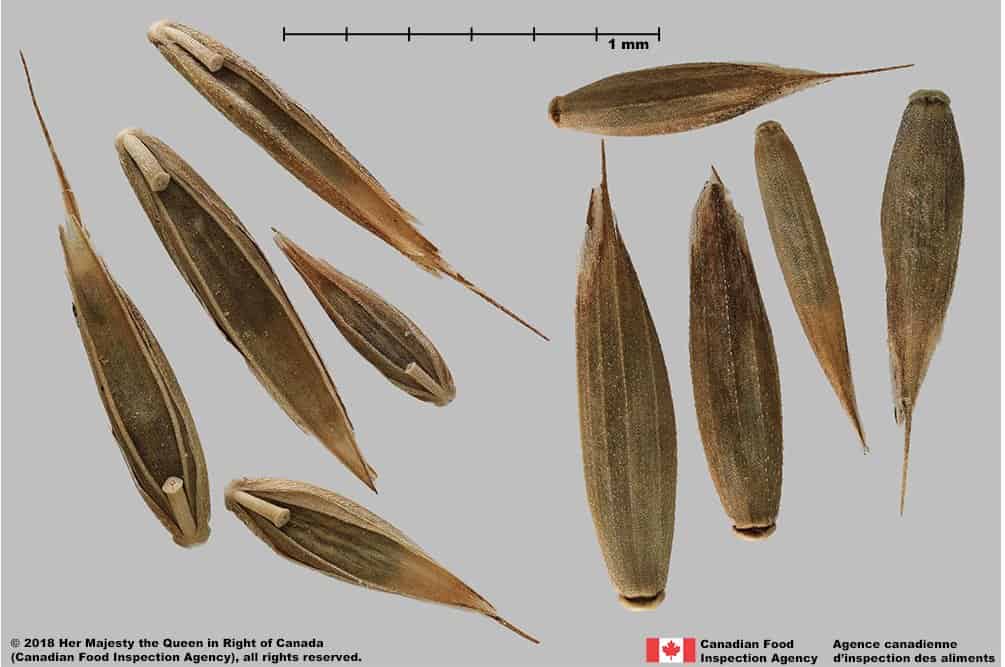
Tall fescue (Festuca arundinacea) florets

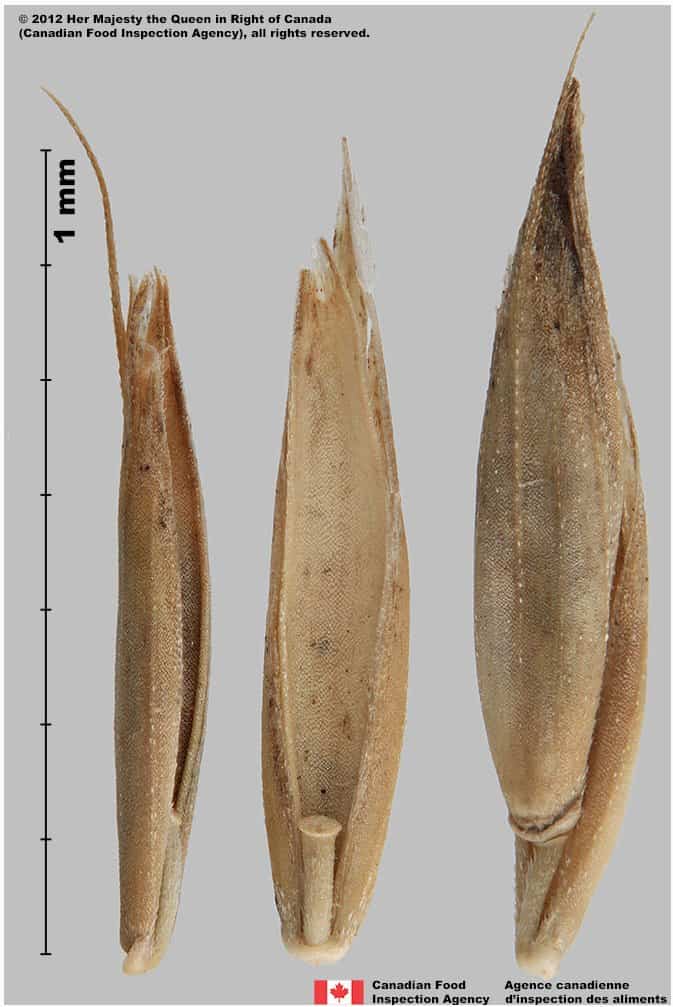
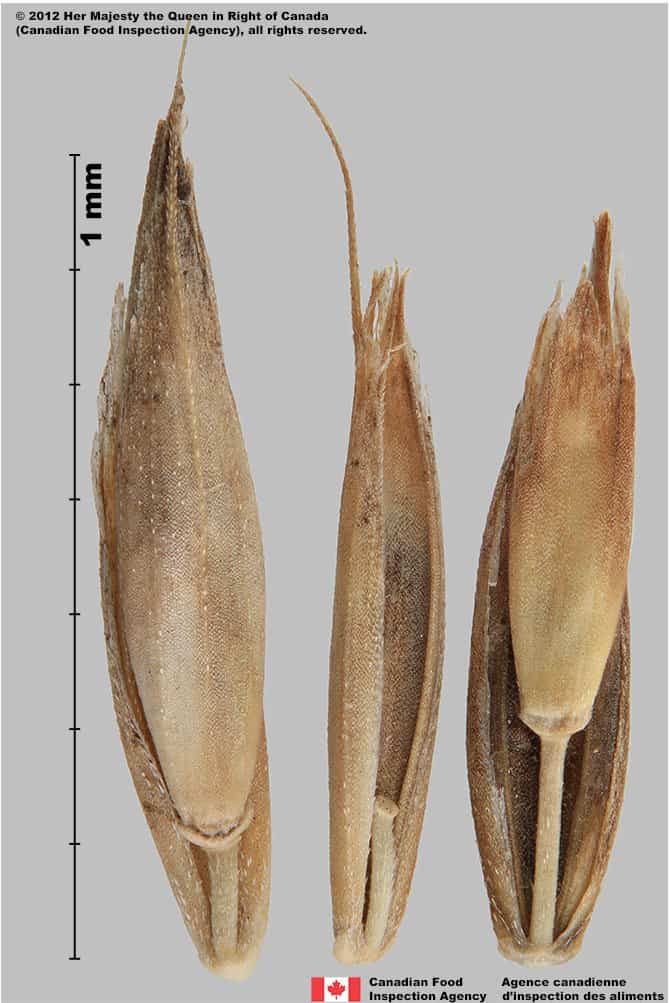
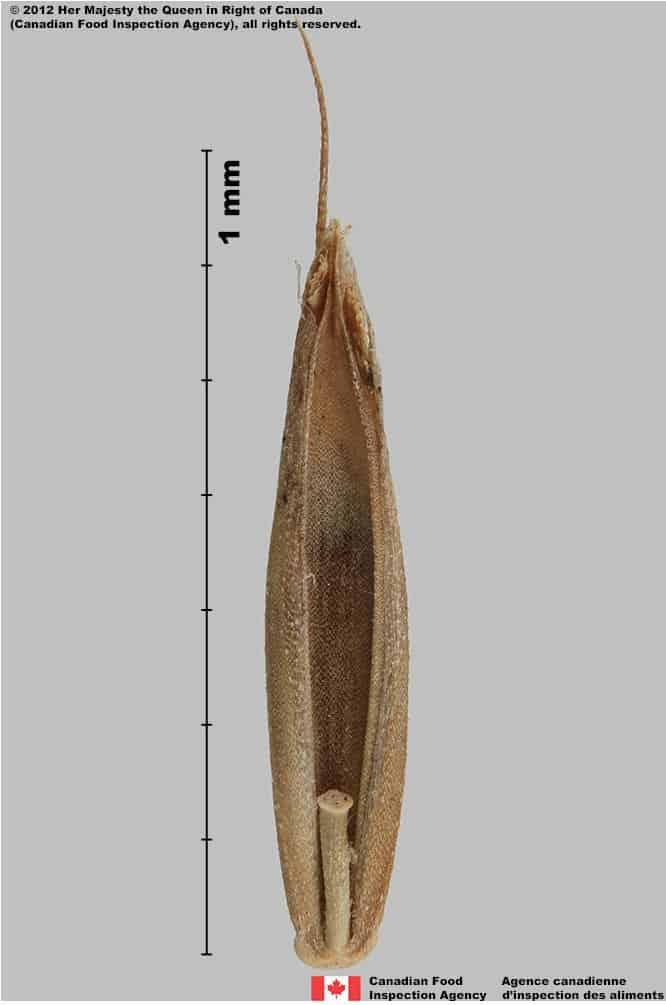
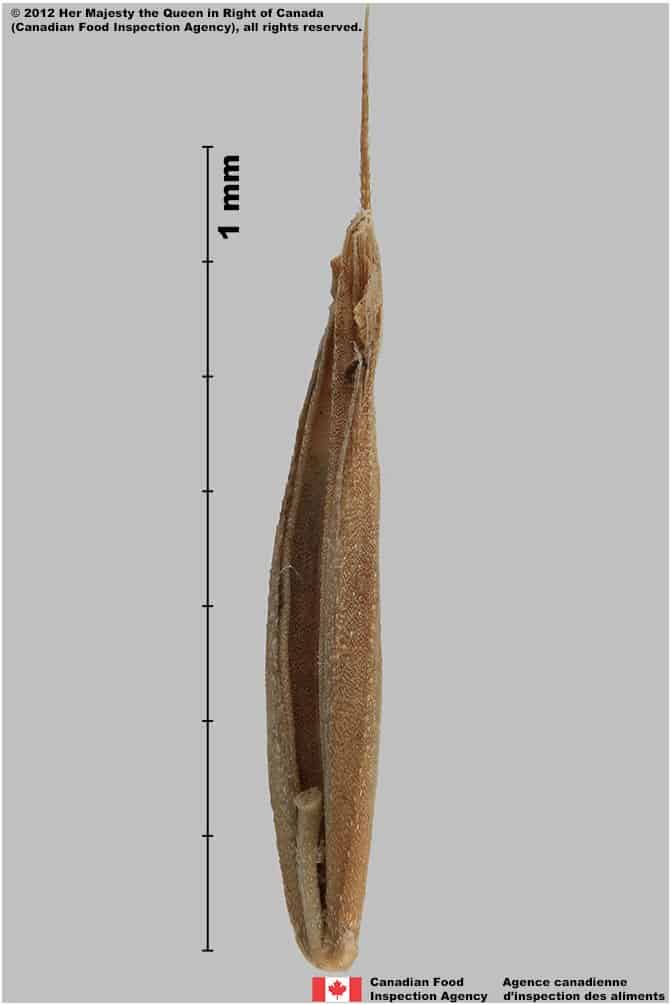
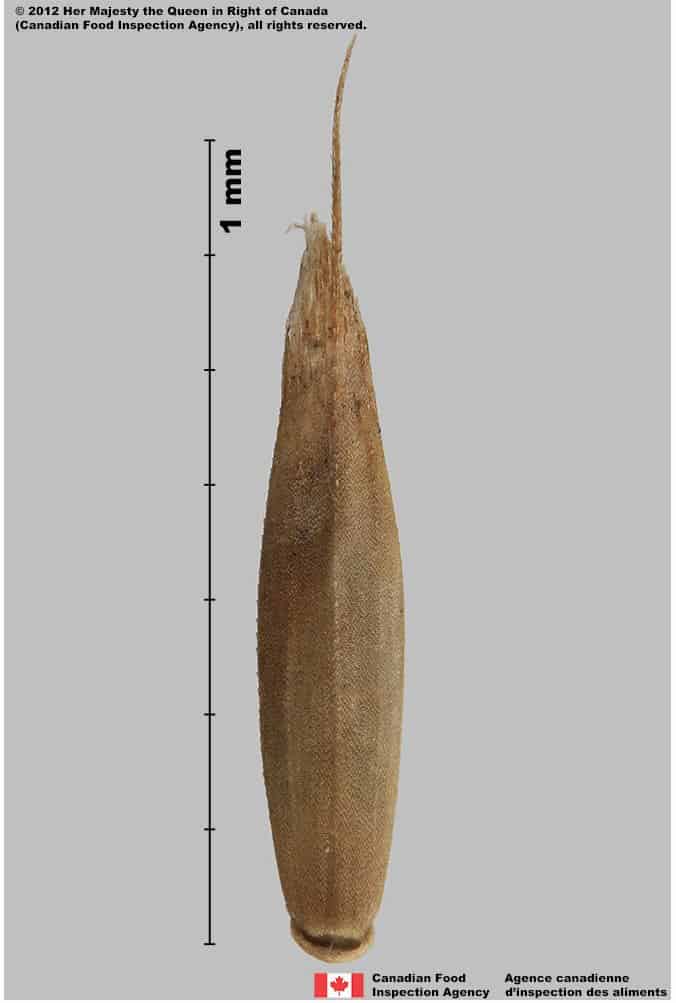
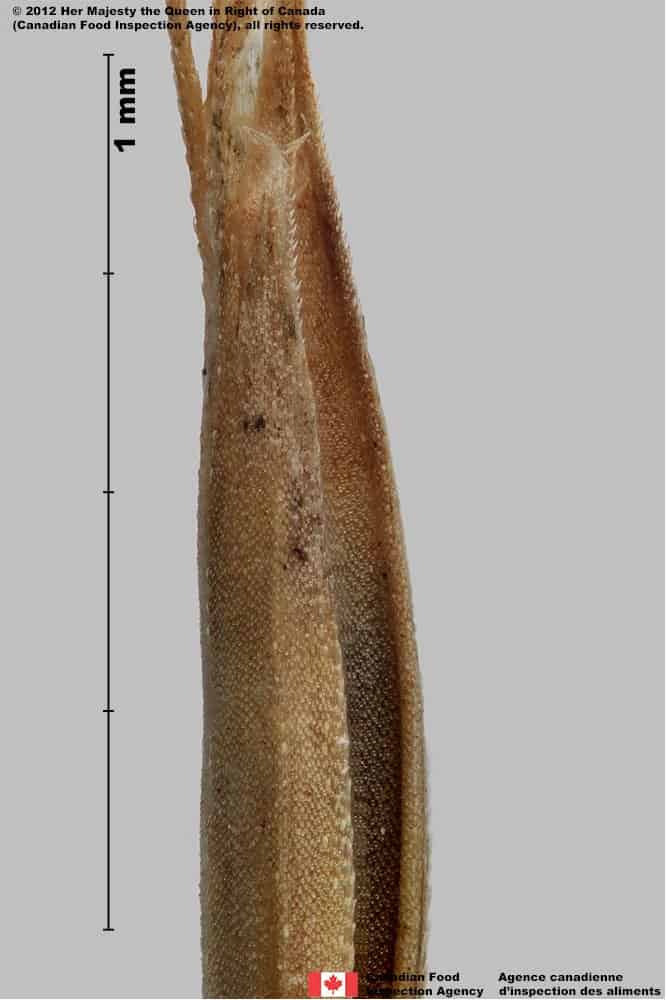
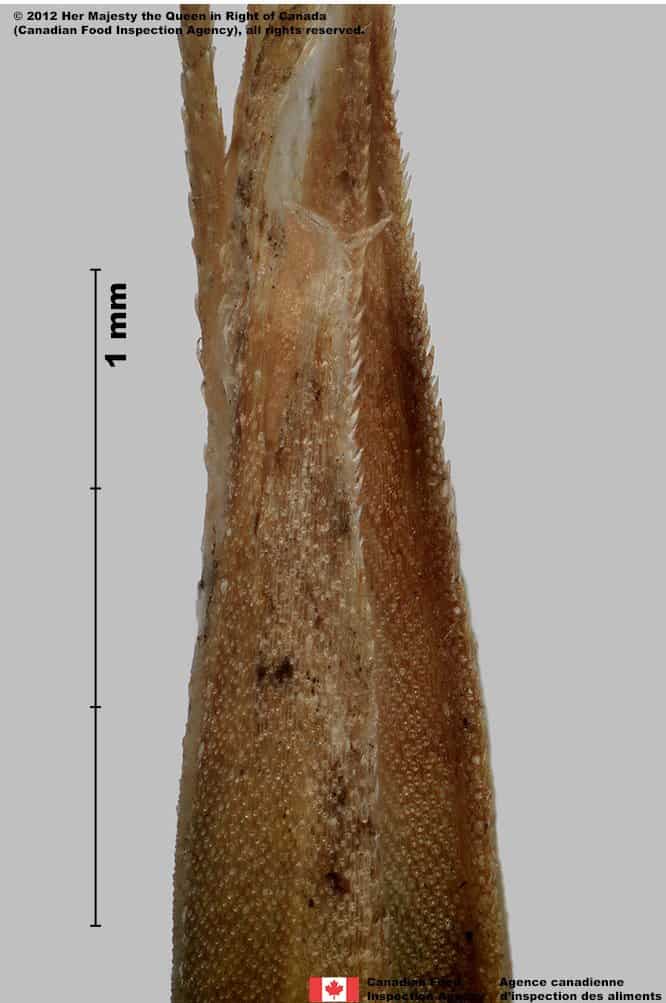
-
Caryopsis
Size
- Caryopsis length*: 3.3 – 4.2 mm (average 3.8 mm); caryopsis width: 1.1 – 1.4 mm (average 1.3 mm).
- Hilum length*: 1.8 – 3.11 (average 2.5 mm).
Note:* Minimum and maximum based on 10 caryopses in a normal range of this species using image measurement protocol (ISMA 2020).
Size measurements from literature:
• Caryopsis length: 2 – 4 mm; caryopsis width: 0.9 – 1.6 mm (Barkworth et al. 2007).
• Caryopsis length: 3 – 3.5 mm; caryopsis width 1.3 – 1.5 mm (Bojňanský and Fargašová 2007).Shape
- Caryopsis oblong, oval, or egg-shaped, dorsal-ventrally compressed, longitudinal depression on hilum side.
Surface Texture
- Caryopsis smooth to slightly rough textured.
Colour
- Caryopsis brown coloured, sometimes with purplish tinge.
Other Features
- Hilum linear, located in a longitudinal depression, extending about one-half to three-quarters the length of the caryopsis from the base.
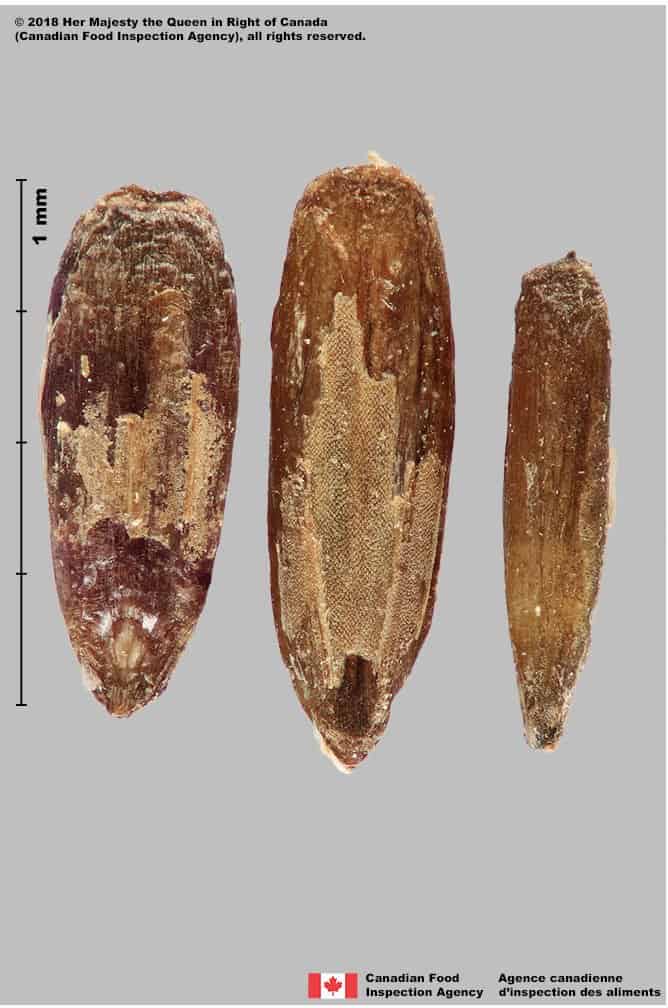
Tall fescue (Festuca arundinacea)

-
Embryo
Size
- Embryo length*: 0.6 – 1.1 mm (average 0.8 mm).
- Embryo one-fifth to one-quarter the length of caryopsis.
Note:* Minimum and maximum based on embryos of 10 caryopses in a normal range of this species using image measurement protocol (ISMA 2020).
Shape
- Oval or teardrop-shaped.
Endosperm
- Endosperm solid (Terrell 1971).
Other Features
- Embryo position lateral.
Identification Tips
CONSEILS POUR L’IDENTIFICATION
- Dispersal units (florets and caryopses) of Festuca arundinacea are similar to those of other Festuca pratensis, F. rubra, and Lolium perenne.
- Plants of F. arundinacea are very similar looking to F. pratensis; however, F. arundinacea has fewer florets per spikelet (CABI 2022).
- Floret size range of F. arundinacea can overlap with that of L. perenne, F. pratensis, and F. rubra, but florets of F. pratensis and F. rubra tend to be smaller.
- In commercial seed mixtures of F. rubra and F. arundinacea, large florets of F. rubra and small florets of F. arundinacea overlap in size but can be separated based on the roughness of the lemma in F. arundinacea and the tuft of hairs located at the tip of the palea of F. rubra (subspecies rubra and commutata), which is lacking in F. arundinacea.
- The lemmas of F. arundinacea are rough granular textured and usually awned, whereas the lemmas of F. pratensis and L. perenne are smooth, may have some short stiff hairs near the margins and apex, and are usually unawned. The lemmas of F. rubra are more transparent than those of F. arundinacea.
- The entire palea surface in F. arundinacea is coarsely granular textured, whereas the paleas of F. pratensis and L. perenne are coarsely granular textured in the lower half and smooth and lustrous in the upper half.
- The rachilla segments of F. arundinacea are straight and cylindrical, in L. perenne flat and strap-like, and in F. pratensis they are oval to somewhat flattened and are straight or twisted to one side. This is a key distinguishing character among the three species for the majority of florets in the spikelet. Unfortunately, rachilla segments of the small florets from the terminal end of the spikelet in all three species are usually long and slender, rendering this feature in small florets diagnostically unreliable.
- For further identification tips see the comparison table under the similar species section.

Tall fescue (Festuca arundinacea) floret








Additional Botany Information
AUTRES RENSEIGNEMENTS BOTANIQUES
Flowers/Inflorescence
- Panicle lax, 10 – 35 cm long; lowest node of panicle with 2 – 3 branches, each with 5 – 15 spikelets (Tutin et al. 1980; Barkworth et al. 2007).
- Anthers 3 (Cronquist et al. 1977).
- Anther length 2.5 – 4 mm (Cronquist et al. 1977; Barkworth et al. 2007).
- Ovary glabrous (Barkworth et al. 2007).
Vegetative Features
- Plants are tufted or form a coarse sod, sometimes rhizomatous; stems up to 1.5(2) m tall; ligules 1(2) mm long; auricles with long hairs (Tutin et al. 1980; Barkworth et al. 2007).
Similar Species
ESPÈCES SEMBLABLES
Similar species are based on a study of seed morphology of various species, and those with similar dispersal units are identified. The study is limited by physical specimen and literature availability at the time of examination, and possibly impacted by the subjectivity of the authors based on their knowledge and experience. Providing similar species information for seed identification is to make users aware of similarities that could possibly result in misidentification.
Festuca pratensis Huds.
Meadow fescue (English) (Wiersema and León 1999; Barkworth et al. 2007; AOSA 2021; CFIA 2021)
Festuca pratensis, meadow fescue has about the same size floret as F. arundinacea but the lemma is smoother in surface texture, the tip of the floret opens out nearly flat, the palea is lustrous in the upper half, and the rachilla is flattened.
Festuca rubra L. subsp. rubra
Creeping red fescue (English) (AOSA 2021; CFIA 2021)
Festuca rubra, red fescue florets are usually smaller in size, the lemma and palea are thinner, the palea has a tuft of hairs at the tip, which is lacking on the palea tip of F. arundinacea.
Lolium perenne L.
Perennial ryegrass (English) (Wiersema and León 1999; AOSA 2021; CFIA 2021)
Lolium perenne, perennial ryegrass florets can be similar in size to F. arundinacea but are usually oblong in shape with a blunt base and tip, the lemma surface is smooth in texture, the tip of the floret opens nearly flat, the palea is lustrous in the upper half, the callus is a thin straight ridge, and the rachilla is flat and strap-like.
Comparison of Similar Species
| Festuca arundinacea | Festuca pratensis | Festuca rubra subsp. rubra | Lolium perenne | |
| Floret shape | Narrowly tear-drop-shaped, widest near mid-point, slightly in-rolled forming a longitudinal depression of the palea of the lower half of the floret | Narrowly oval to oblong, widest near mid-point, opening broadly in upper half of floret, tip of lemma may taper abruptly to a short narrow point | Narrowly teardrop-shaped, widest near mid-point | Oblong; sides mostly parallel, opening broadly in upper half of floret, tip usually squared or slightly rounded, but can be slightly tapered toward tip |
| Floret length (mm)* | 4.3 – 8.2 | 4.6 – 6.9 | 3.4 – 7.7 | 4.1 – 9.9 |
| Floret width (mm)* | 0.9 – 1.7 | 0.9 – 1.9 | 0.7 – 1.3 | 0.9 – 1.9 |
| Awn length (mm)* | 0.3 – 3.3 | 0 – 0.4 | 0.3 – 2.9 | Usually not awned |
| Caryopsis shape | oblong, oval, or egg-shaped, dorsal-ventrally compressed, longitudinal depression on hilum side | oblong, oval, or egg-shaped, dorsal-ventrally compressed, longitudinally depressed on hilum side | narrowly oblong, oval, or egg-shaped, dorsal-ventrally compressed | mostly oblong or elliptic, dorsal-ventrally compressed |
| Caryopsis length* (mm) | 3.3 – 4.2 | 3.0 – 3.6 | 2.9 – 4.1 | 2.7 – 5.6 |
| Caryopsis width (mm)* | 1.1 – 1.4 | 1.1 – 1.3 | 0.8 – 1.0 | 1.0 – 1.7 |
| Hilum length (mm)* | 1.8 – 3.1
one-half to three-quarters the length of the caryopsis from the base |
2.4 – 3.3
about four-fifths the length of the caryopsis from the base |
2.0 – 3.1 | 1.8 – 3.9
about two-thirds the length of the caryopsis from the base |
| Lemma surface texture | Coarsely granular with short stiff hairs near margins, along nerves, and near tip of lemma | Smooth to finely granular; may have short stiff hairs near tip of lemma | Smooth, hairless or covered with short stiff or soft hairs especially near the tip | Smooth to finely granular |
| Palea surface texture | Coarsely granular from base to tip | Coarsely granular in lower half and smooth and lustrous in upper half | Palea papery, coarsely granular and with tuft of short hairs near the tip | Granular in lower half and smooth and lustrous in upper half |
| Rachilla | Slender, round in cross-section with slightly flared disk at apex, straight, may be sparsely short-hairy | Slender, oval to slightly flattened in cross-section with slightly flared disk at apex, may curve to one side, smooth or may have short stiff hairs | Straight, slender, round in cross-section with flared disk at tip, may be covered with short hairs | Flat, wide, strap-like, apex usually not flared, straight, usually smooth or may short hairs |
| Callus | Blunt, thick ridge, slightly curved along bottom edge, often with deep transverse indentation between the upper edge and lemma | Blunt, thick ridge, bottom edge nearly straight or irregularly puffy, with a deep transverse indentation between the upper edge and lemma | Blunt with a thick rounded ridge on the lemma side | Blunt, narrow ridge, nearly straight along bottom edge |
* Minimum and maximum measurement of structures in a normal range of these species using image measurement protocol (ISMA 2020).
Click to select species
Cliquez pour sélectionner les espèces
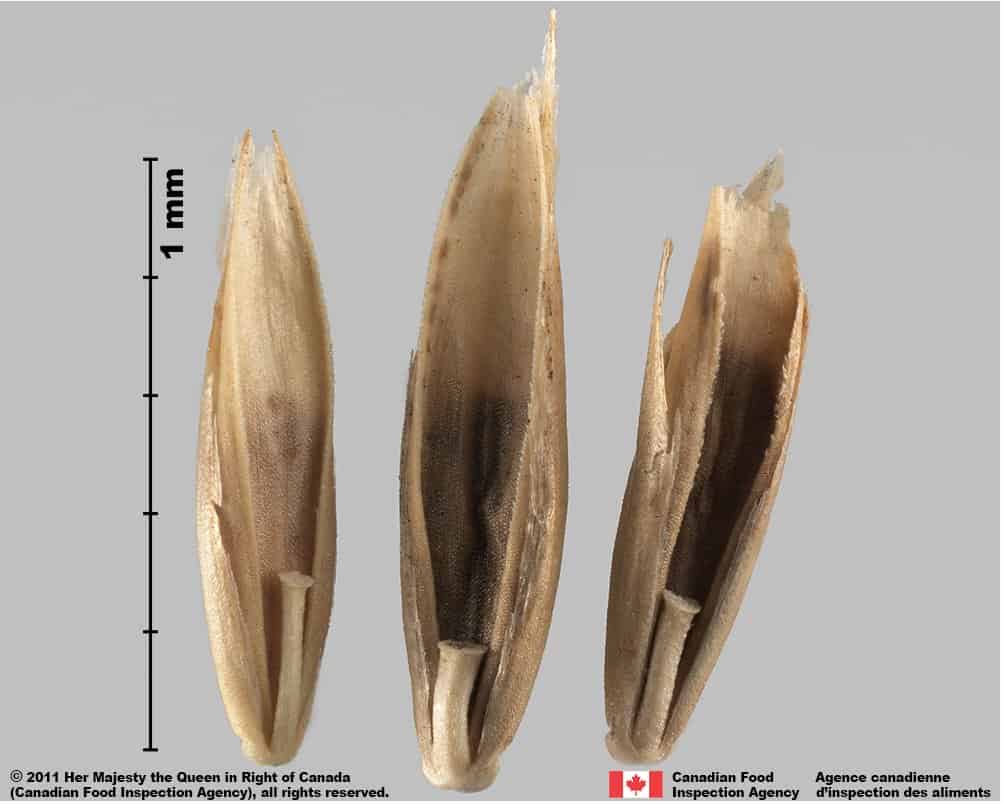
Festuca pratensis
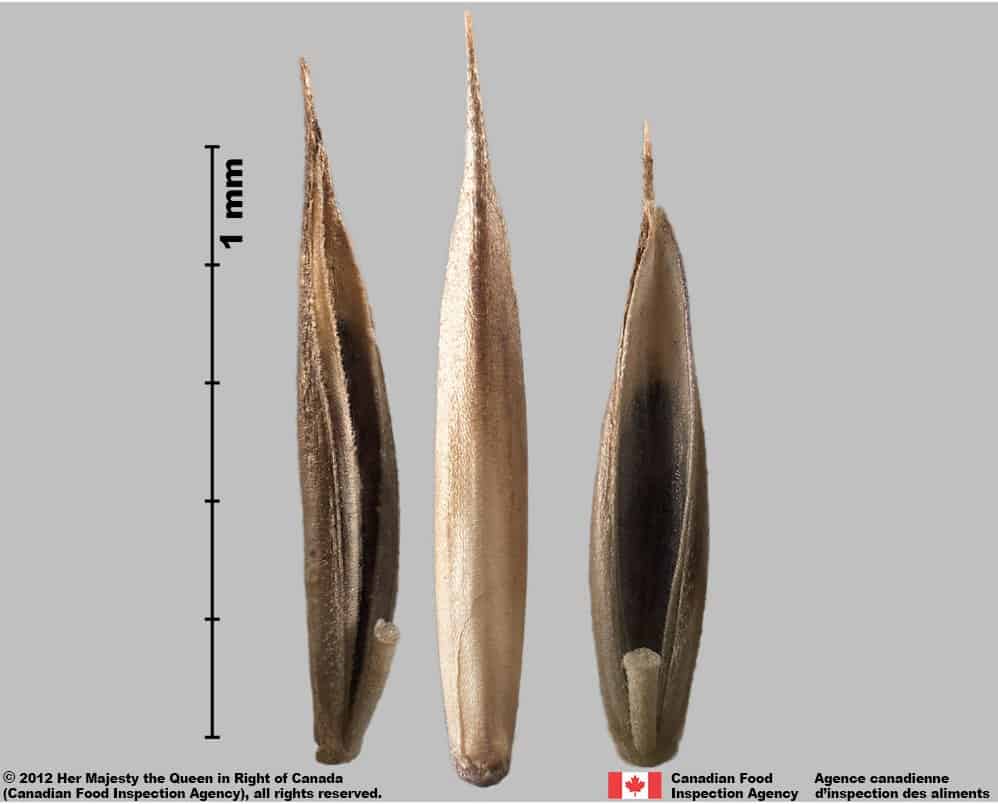
Festuca rubra subsp. rubra
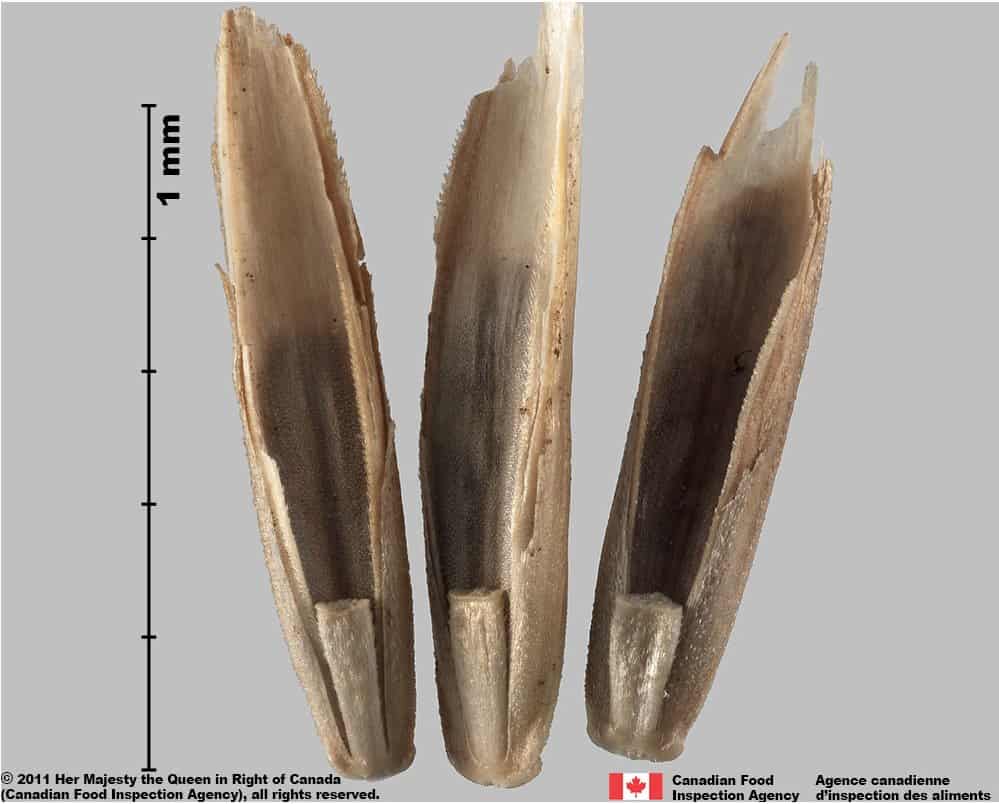
Lolium perenne
Comparison Window
Fenêtre de comparaison
MAIN SPECIES
ESPÈCES PRINCIPALES
Festuca arundinacea

Festuca arundinacea
Poaceae
Tall fescue (Festuca arundinacea) florets
MAIN SPECIES
ESPÈCES PRINCIPALES
Festuca arundinacea

Festuca arundinacea
Poaceae
Tall fescue (Festuca arundinacea) spikelet and florets
MAIN SPECIES
ESPÈCES PRINCIPALES
Festuca arundinacea

Festuca arundinacea
Poaceae
Tall fescue (Festuca arundinacea) spikelets and floret
MAIN SPECIES
ESPÈCES PRINCIPALES
Festuca arundinacea

Festuca arundinacea
Poaceae
Tall fescue (Festuca arundinacea) floret
MAIN SPECIES
ESPÈCES PRINCIPALES
Festuca arundinacea

Festuca arundinacea
Poaceae
Tall fescue (Festuca arundinacea) floret
MAIN SPECIES
ESPÈCES PRINCIPALES
Festuca arundinacea

Festuca arundinacea
Poaceae
Tall fescue (Festuca arundinacea) floret
MAIN SPECIES
ESPÈCES PRINCIPALES
Festuca arundinacea

Festuca arundinacea
Poaceae
Tall fescue (Festuca arundinacea)
MAIN SPECIES
ESPÈCES PRINCIPALES
Festuca arundinacea

Festuca arundinacea
Poaceae
Tall fescue (Festuca arundinacea)
MAIN SPECIES
ESPÈCES PRINCIPALES
Festuca arundinacea

Festuca arundinacea
Poaceae
Tall fescue (Festuca arundinacea)
SIMILAR SPECIES
ESPÈCES SEMBLABLES
Festuca pratensis

Festuca pratensis
Poaceae
Meadow fescue (Festuca pratensis) florets
SIMILAR SPECIES
ESPÈCES SEMBLABLES
Festuca pratensis
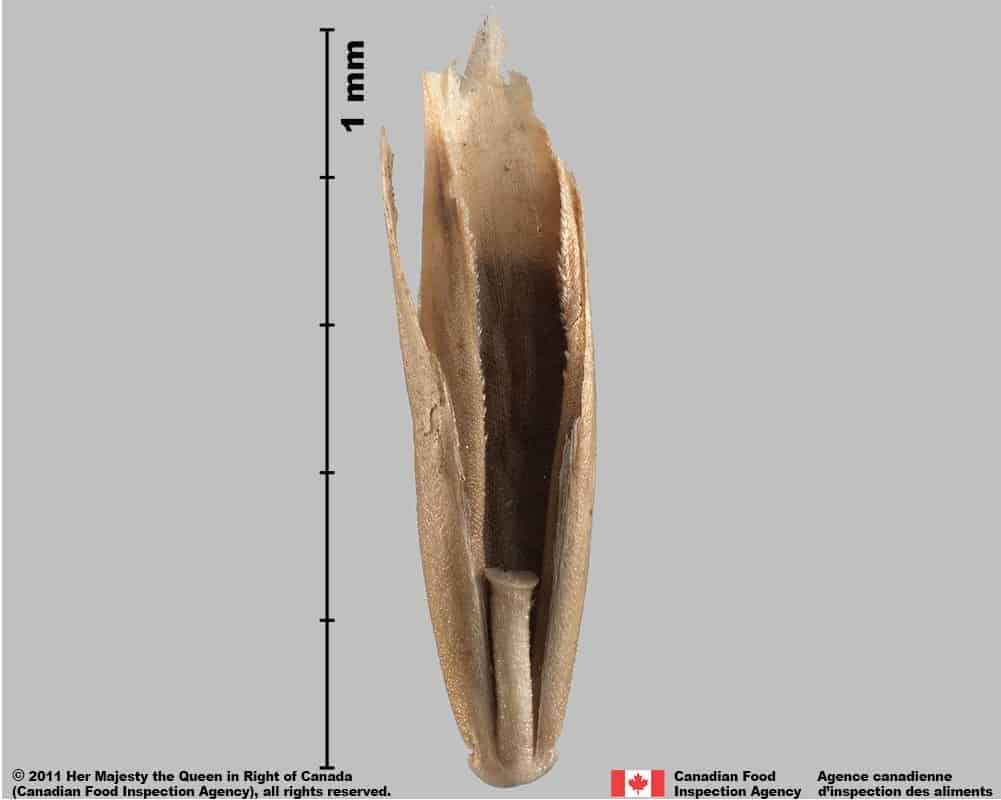
Festuca pratensis
Poaceae
Meadow fescue (Festuca pratensis) floret
Need ID Help?
Besoin d’aide pour l’identification?
Reference(s)
Référence(s)
Alderson, J. & W. C. Sharp. 1995. Grass varieties in the United States, U.S.D.A. Agric. Handbook 170, rev. ed. CRC Press.
Association of Official Seed Analysts (AOSA). 2021. Rules for Testing Seeds, Vol. 3: Uniform Classification of Weed and Crop Seeds. Association of Official Seed Analysts, Washington D. C.
Barkworth, M. E., Capels, K. M., Long, S. and Piep, M. B. (eds.). 2007. Flora of North America Volume 24. Magnoliophyta: Commelinidae (in part): Poaceae, part 1. Oxford University Press, New York, New York.
Bojňanský, V. and Fargašová, A. 2007. Atlas of Seeds and Fruits of Central and East-European Flora: The Carpathian Mountains Region. Springer, Dordrecht, The Netherlands.
Centre for Agriculture and Bioscience International (CABI). 2022. Invasive species compendium, Festuca arundinacea (Tall Fescue). https://www.cabi.org/isc/datasheet/23983 Accessed June 19, 2022.
Canadian Food Inspection Agency (CFIA). 2021. Canadian Methods and Procedures for Testing Seeds (M&P). Version 1.1, English. Canadian Food Inspection Agency.
Cronquist, A., Holmgren, A. H., Holmgren, N. H., Reveal, J. L., Holmgren, P. K. 1977. Intermountain Flora: Vascular Plants of the Intermountain West, U.S.A. Vol. 6: The Monocotyledons. Columbia University Press, New York, NY.
eFloras. 2022. Flora of China. Festuca arundinacea. http://www.efloras.org Accessed May 23, 2022.
International Seed Morphology Association (ISMA). 2020. Method for seed size measurement. Version 1.0. ISMA Publication Guide. https://www.idseed.org/authors/details/method_for_seed_size_measurement.html.
Nihsen, M. E., Piper E. L., West, C. P., Crawford, Jr., R. J., Denard, T. M., Johnson, Z. B., Robers, C. A., Spiers, D. A. and Rosenkrans, Jr., C. F. 2004. Growth rate and physiology of steers grazing tall fescue inoculated with novel endophytes. J. Animal Sci. 82:878-883.
Rolston, M. P., Rowarth, J. S., Young III, W. C., and Mueller-Warrant, G. W. 1997. Grass Seed Crop management. In: Fairey, D. T. and Hampton, J. G. (eds.). 1997. Forage Seed Production. Vol. 1: Temperate Species. CAB International.
Terrell, E. E. 1971. Survey of occurrences of liquid or soft endosperm in grass genera. Bull. Torr. Botan. Club 98(5):264-268.
Tutin, T. G., Haywood, V. H., Burges, N. A., Moore, D. M., Valentine, D. H., Waters, S. M., Webb, D. A. (Eds.). 1980. Flora Europaea. Volume 5: Alismataceae to Orchidaceae (Monocotyledons). Cambridge University Press.
U.S. Department of Agriculture-Agricultural Marketing Service (USDA-AMS). 2022. State Noxious-Weed Seed Requirements Recognized in the Administration of the Federal Seed Act. https://www.ams.usda.gov/sites/default/files/media/StateNoxiousWeedsSeedList.pdf Accessed on May 23, 2022.
U.S. Department of Agriculture-Agricultural Research Services (USDA-ARS). 2022. Germplasm Resources Information Network (GRIN Taxonomy). National Germplasm Resources Laboratory, Beltsville, Maryland, https://npgsweb.ars-grin.gov/gringlobal/taxon/taxonomydetail?id=16631 Accessed May 22, 2022.
Wiersema, J. H. and León, B. 1999. World Economic Plants: A Standard Reference. CRC Press, Boca Raton, FL.
Young III, W. C. 1997. Festuca arundinacea Schreb. (Tall Fescue) in the USA. In: Fairey, D. T. and Hampton, J. G. (eds.). 1997. Forage Seed Production. Vol. 1: Temperate Species. CAB International.



